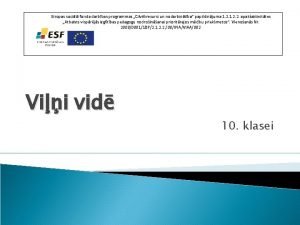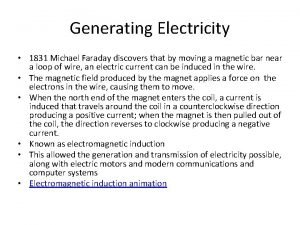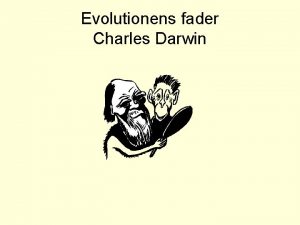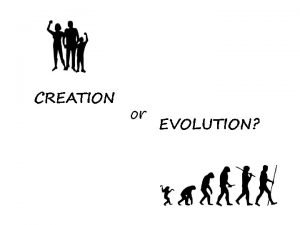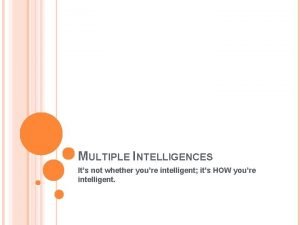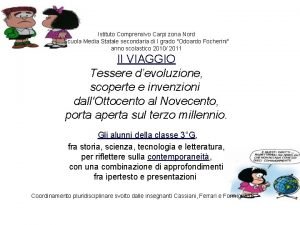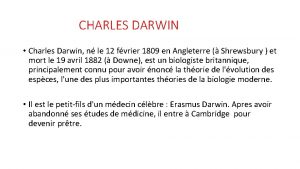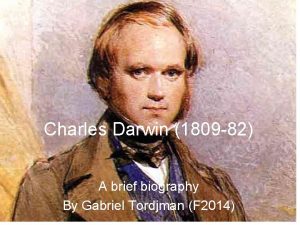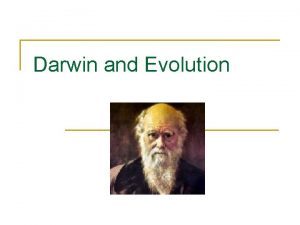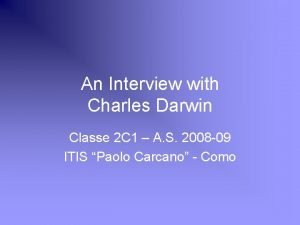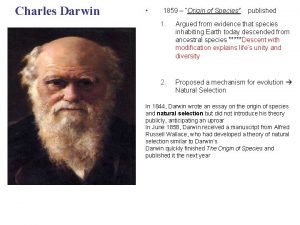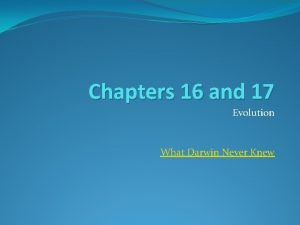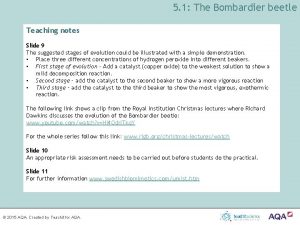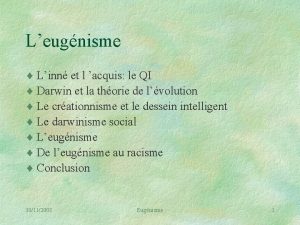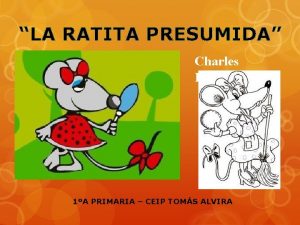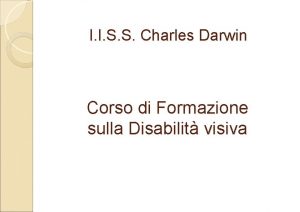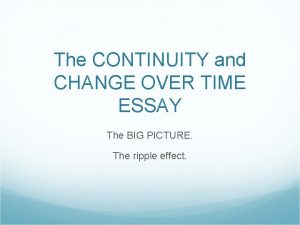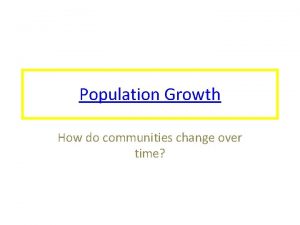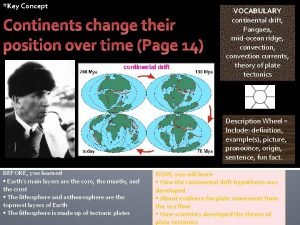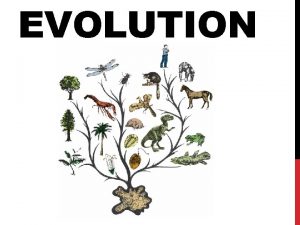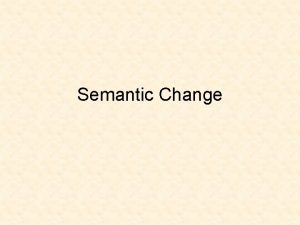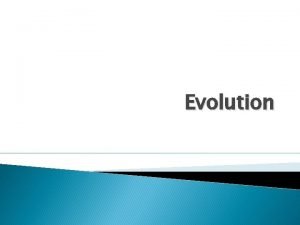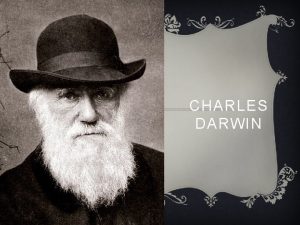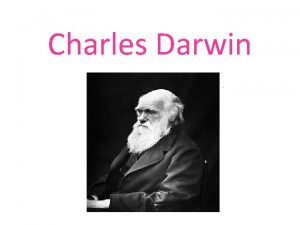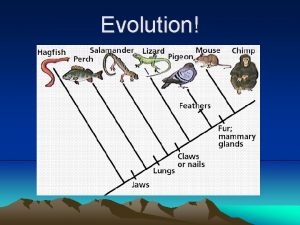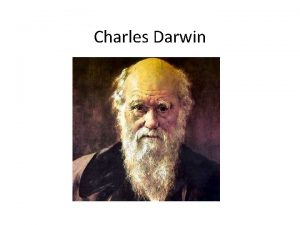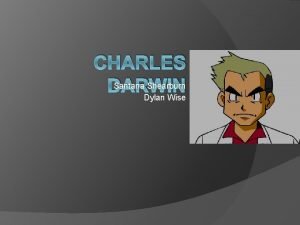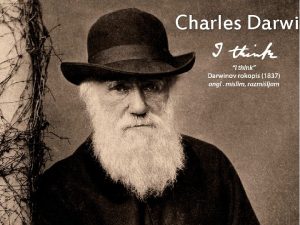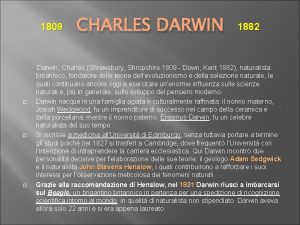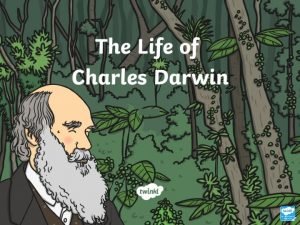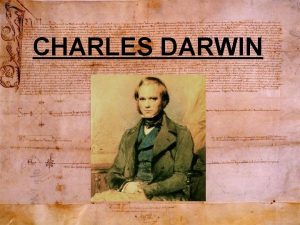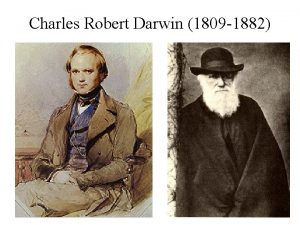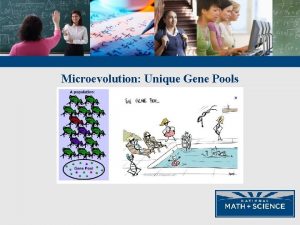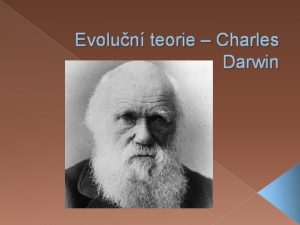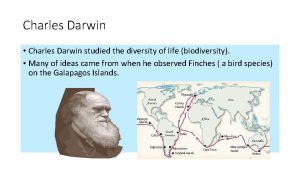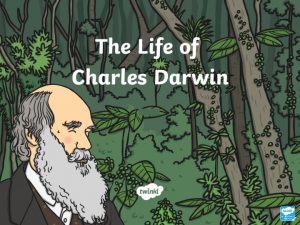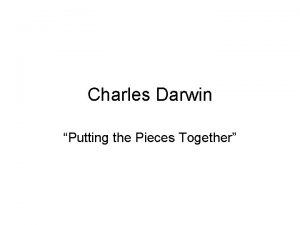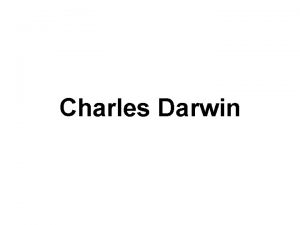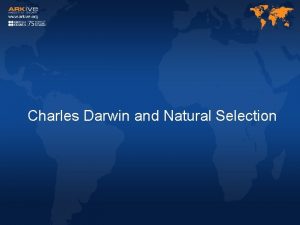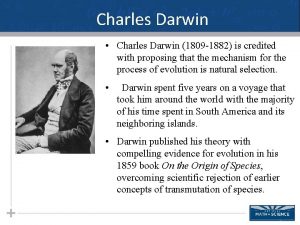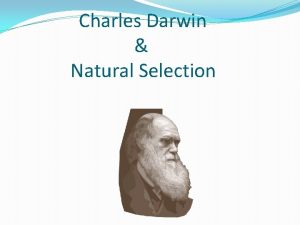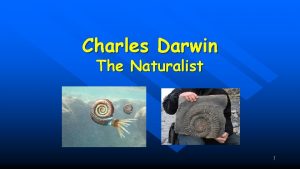Change Over Time Who was Charles Darwin 1831
































- Slides: 32

Change Over Time

Who was Charles Darwin? • 1831 • HMS Beagle set sail from England on a 5 year trip of discovery…. . • Darwin’s job was to learn as much as possible about the living things he saw on the voyage. • He saw many plants and animals he had never seen before • His discoveries led him to develop a scientific theory of evolution by natural selection.

Species: • Scientists estimate that there are 1. 7 million species of organisms on Earth. • Species – a group of similar organisms that can mate with each other and produce fertile offspring.

Galapagos Island • Here Darwin observed many unusual life forms • Giant Tortoise • Lizards • Seals

Similarities and Differences • Darwin noticed that some animals found on the Galapagos Island were similar to the animals found on the mainland (South America)

How did these creatures get here? • Darwin inferred that a small number of different plant and animal species had come to the Galapagos from the mainland. • Blown out to sea during a storm • Floated on a drifting log • Over time (millions of years), their offspring changed into what they are today….

Adaptations: • Birds – Finches • Differences depending on which island they came from • Size and shape of beaks • Eat insects: beaks were sharp, needlelike • Eat seeds: beaks had strong, wide beaks • Adaptation – a genetic trait that helps an organisms survive and reproduce

Theory of Evolution • Darwin spent 20 years studying his findings • Darwin reasoned that plants and animals that arrived on one of the Galapagos Islands faced conditions that were different from those on the mainland. • Perhaps species gradually changed over many generations and became better adapted to the new environment…… • Evolution – the change in species over time

Selective Breeding: • Evidence to support his theory of evolution

Natural Selection • Natural selection – the process by which individuals that are better adapted to their environment are more likely to survive and reproduce than other members of the same species. • Affecting factors: – Overproduction – Competition – Variation

Overproduction: • Most species often produce more offspring than can possibly survive • Why? What is passed on to the next generation?

Competition: • Food and other resources are limited • Members of species must compete with each other to survive. • Can lead to starvation and being prey for predators • Will the weak be able to pass on their DNA?

Variation: • Members of a species differ from one another in many of their traits • Any difference between individuals of the same species is called a variation. – Example: baby turtles swimming faster than their siblings…. . WHY? • Some variations can make an individual better adapted for survival.

Natural Selection: • Surviving offspring will live to pass on their helpful traits to their offspring. • This cycle of passing on the helpful traits keeps on going • The environment has “selected” individuals with the necessary traits for survival • Over long periods of time – this can lead to change

Example of Natural Selection: • New predator is introduced into an environment • Those that can outrun the predator will survive • They will be able to pass on their “fastrunning” genes on to their offspring. • The slow runners will slowly disappear…. . why? • Over LONG periods of time, the entire species will have the “fast-running” gene.


How does a new species form? • Variations can lead to a new species • Geographic isolation – complete separation from the original species – River, volcano, mountain range, storm washing animals into sea and eventually landing on an island, earthquake • Once isolated, the members of a species can no longer mate with the original group • Accumulation of different traits

Continental Drift…. • Pangaea – supercontinent • Over millions of years, Pangaea gradually drifted apart due to continental drift (convection currents) • Climates changed • Species became isolated from one another • Natural selection occurred • Example: Australia Marsupials

Fossil Record

What is a fossil? • In order to understand what occurred long ago, scientists act like detectives to solve clues…. using fossils! • Fossil – preserved remains or traces of an organism that lived in the past. – Bone, tooth, shell, footprints, worm burrows, etc…. . – Formed when organisms become buried under sediments after they die.

Determining a Fossils age…. . • The age of a fossil can be used to reconstruct the history of life on earth. • Relative Dating: Looking at the layers of rock top layer is the newest, bottom layer is the oldest. • Absolute Dating: Using the actual radioactive elements found in the fossils

Fossil Record: • The millions of fossils that scientists have collected are called the fossil record. • Almost all of the species preserved as fossils are now extinct. • Extinct – NO members of a species are still alive • Scientists use the fossils and foot prints to rebuild and understand the creature • Provides evidence about WHEN different kinds of organisms may have lived on earth. • Estimate ages of fossils – created a “calendar” of events that date back 4. 6 billion years!! – Geological Time Scale

Incomplete Fossil Record • The fossil record is incomplete because most organisms that died did not leave behind fossils. • These gaps have left many unanswered questions. • Scientists do not know how rapidly species change.

Causes of extinction: • Changes in environmental conditions can affect the survival of species.

Causes of extinction: • Natural events • Major changes in climate • An asteroid threw huge clouds of dust and gas into the atmosphere • The dust clouds blocked the sunlight, making the climate cooler and killing plants. • Herbivores died • Carnivores died • Massive volcanic eruptions

Causes of extinction: • • • Human activities Habitat destruction Loss of environment Pollution Hunting and killing too many of a species

Other Evidence of Change

Similarities in body structure: • Scientists compare body structures of living organisms • Body structures: basic body plan – How the bones are arranged – Organ systems • Fish, amphibians, reptiles, birds and mammals all have similar body plans. – Internal skeleton with a backbone

Homologous structures: Scientists use the similar structures of forelimbs as evidence that these three organisms share a common ancestor.

Similarities in early devolvement • Scientists also make inferences about evolutionary relationships by comparing the early development of different organisms. • Compare a bird, frog and rat…. . very different right? • HOWEVER, during early development, these organisms have some similarities.

Similarities in DNA: • Scientists compare genes of different species to determine possible relationships among species. • Compare DNA • More similar two species DNA is, the more closely related they are – Horse and zebra – Lion and tiger – Cat and dog?

Combining the Evidence: • Scientists have combined evidence from fossils, body structures, early development, and DNA … – Example: Scientists have inferred that dogs were more closely related to wolves than to coyotes based on similarities in body structure, DNA and early development. • Branching Tree – a diagram that shows how scientists think different groups of organisms are related. Common Ancestor
 Skotu ķīmiķis 1831-1892
Skotu ķīmiķis 1831-1892 Curtis v chemical cleaning
Curtis v chemical cleaning Angļu fiziķis 1831-1879
Angļu fiziķis 1831-1879 Hegel
Hegel 1831 faraday
1831 faraday Vem var charles darwin
Vem var charles darwin Where was charles darwin born
Where was charles darwin born Explain the theory of evolution
Explain the theory of evolution Where was charles darwin born
Where was charles darwin born Existential intelligence
Existential intelligence Charles darwin origine della specie
Charles darwin origine della specie Giustificazione dello schiavismo versione greco
Giustificazione dello schiavismo versione greco Charles darwin vikidia
Charles darwin vikidia Where was charles darwin born
Where was charles darwin born Charles darwin notes
Charles darwin notes Sneakers head
Sneakers head Charles darwin
Charles darwin Darwism
Darwism Charles darwin
Charles darwin Charles darwin
Charles darwin Bombardier beetle darwin
Bombardier beetle darwin Charles darwin vs lamarck
Charles darwin vs lamarck Qi de darwin
Qi de darwin Una oración con gallo
Una oración con gallo Isis charles darwin
Isis charles darwin Origin of species by charles darwin
Origin of species by charles darwin Continuity and change over time example
Continuity and change over time example Why do communities change over time
Why do communities change over time A change of position over time
A change of position over time The gradual change in a species over time
The gradual change in a species over time What is semantic shift
What is semantic shift Change in hereditary features over time
Change in hereditary features over time A gradual change in a community over time.
A gradual change in a community over time.


